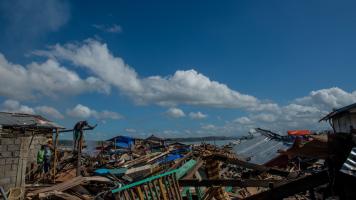In 2023, the warmest year on record, heatwaves, floods, droughts, wildfires and tropical cyclones intensified across the world, with devastating effects on Southeast Asia and other climate-vulnerable regions. Photo credit: ADB.
The United Nations has called for a doubling of adaptation finance, which is the priority for countries most affected by climate change.
Though among the world’s most climate-vulnerable areas, Southeast Asia receives only a small fraction of adaptation and mitigation financing. Access to climate finance is hampered by a lack of bankable projects, regulatory uncertainty, and limited data and knowledge. An integrated approach is needed to address policy gaps and align climate ambitions with sector and fiscal planning.
In 2018–2019, climate finance flows to Southeast Asia amounted to just $27.8 billion or 5% of the nearly $520 billion tracked for Asia and the Pacific. According to the Climate Policy Initiative, the region requires up to $1.7 trillion annually until 2030 to meet climate targets, while early estimates of ADB put climate finance needs of Southeast Asian countries at $210 billion per year. However, these figures will likely be adjusted as countries scale up national climate action plans to tackle a worsening climate crisis and to transition to a green economy.
A key focus of the COP29 climate talks in Baku, Azerbaijan in November is climate finance. A new global climate finance target is expected to be set this year to help address the needs and priorities of developing countries. The previous goal was to provide $100 billion annually by 2020, which wealthier countries were only able to reach in 2022, providing a total of $115.9 billion. Multilateral public climate finance was a key driver in meeting the goal. A key challenge is to increase adaptation finance, which grew threefold from 2026 but is still less than 30% of the total.
The United Nations has called for a doubling of adaptation finance, which is the priority for countries most affected by climate change.
Aligning plans and actions
To gain access to more climate finance, Southeast Asian countries need to broaden the policy and enabling environment for climate action and put in place institutional and planning frameworks to support a pipeline of high-quality climate projects, said Naeeda Crishna Morgado, senior infrastructure specialist (climate finance) at ADB’s Southeast Asia Department.
Ahead of COP29, a webinar hosted by ADB’s Southeast Asia Green Finance Hub, the ASEAN Catalytic Green Finance Facility (ACGF), and SEADS looked at the climate finance landscape of Southeast Asia and examined gaps, challenges, and opportunities.
Luthfyana Larasati, a manager at Climate Policy Initiative, said climate projects face risks such as cost overruns, delays, and permit risks, reflecting regulatory uncertainty. There is lack of transparency and disclosure because of data gaps and limitations in tracking and reporting. Mitigation receives the lion’s share of financing. Investor sentiment is low on adaptation projects because they are fragmented in nature, small in scale, and context specific (e.g., building storm-resistant housing, planting drought-tolerant crops, installing reliable water supplies, investing in social safety nets). Another constraint is the lack of universally accepted impact metrics for adaptation finance. Equity flowed almost exclusively to energy investments (i.e., renewables).
Morgado said countries need to integrate climate action into national plans and budgets, strengthen the links between climate policy and sector planning and improve accountability mechanisms and transparency. “One of the main issues in almost any country in Southeast Asia is that NDC [nationally determined contribution] targets or national adaptation plans, are not really reflected in sector plans, except for energy. This is a key area for multilateral development banks and a big focus of ADB sector action.”
Another important area is working with ministries of finance and planning to make public financial management more climate-responsive and to integrate NDCs and national adaptation plans into systems (i.e., budget processes, procurement).
ADB is supporting the ASEAN Climate Finance Policy Platform initiative, which helps finance ministries catalyze climate action. It recognizes that the role of finance ministries is becoming increasingly pivotal in addressing climate-related fiscal risks and mobilizing climate finance.
One way to improve the bankability of investments is to consolidate and aggregate projects, such as urban development projects, to access long-term finance. Strategic and effective planning and project preparation, including diagnostic work for assessing climate risks, are vital in ensuring investment-ready projects and intended climate outcomes are achieved.
Mobilizing private capital
The world needs at least $4.8 trillion annually, or a 20% year-on-year increase by 2030, to avoid the worst climate impacts. Private sector financing is critical in supporting large-scale investments to significantly reduce emissions and adapt to the adverse effects of climate change.
ADB is elevating its ambition to deliver climate financing to its developing member countries to $100 billion in 2019–2030. Of the total, $12 billion in climate finance is intended to support private initiatives. ADB aims to crowd in an additional $18 billion to $30 billion.
Studies show climate action opens new business opportunities, such as low-carbon technologies.
In Southeast Asia, however, the lack of bankable revenue models for adaptation hinders investments, said Tristan Knowles, senior investment specialist at ADB’s Private Sector Operations Department. Grants are still required to make the investment viable. These cover policy and knowledge support for adaptation finance and climate risk assessments.
ADB is now preparing its Private Sector Climate Ambition Plan, which explores economy-wide opportunities to support decarbonization and climate resilience.
